Conflicts of the Land Use and Ecosystem Services in the Riverine Landscape of the Little Danube
Abstract
:1. Introduction
2. Materials and Methods
- (1)
- Geosystem analysis and synthesis of the objective properties of the landscape as a basis for other applications
- (a)
- Primary landscape structure—The abiotic components like the bedrock and Quaternary layers, microrelief, soils, and micro- and mesoclimates. They create environments and borders for the flow of water, material, and energy in geosystems;
- (b)
- Secondary/current landscape structure—The existing physical and biological conditions (i.e., selective criteria), and the biotic components, including land use and land cover, artificial objects in the landscape that affect water retention in the landscape, evapotranspiration, and the ecological stability of the landscape;
- (c)
- Tertiary landscape structure—Socioeconomic phenomena of the landscape for the real use of the ES potential (i.e., implementation criteria) [9].
- (2)
- Evaluation of the selected ESs as an applied methodology for the interpretation of objective landscape characteristics
- (a)
- A participatory approach based on a field survey and an expert evaluation to select the indicators [14,17,34]. An interdisciplinary team of experts studied the area, selected the indicators that are relevant for the provisioning of the selected ESs, and assigned weights to them. The selected indicators of the primary, secondary, and tertiary landscape structures respect the character of the model area, most significantly affect the spatial differentiation and division of the properties of geosystems in the model area, and, thus, most significantly affect the differentiation of the ESs provided (Table 1).
- (b)
- A biophysical assessment approach based on the relationship between pressures on the ecosystems, ecological status, and the delivery of ESs to evaluate the ESs in the study area and their benefits. We used a Green Frame methodology scheme that was based on a comparison of the positive (support for the use of ESs) and negative (restrictions on the provision of ESs) elements of the landscape indicators [35] (Table 1).
- (3)
- Proposal of management measures for the optimal use of ESs
3. Results
3.1. Primary Landscape Structure (PLS)
3.2. Current Landscape Structure (CLS)
- (1)
- Land use/land cover—The basic frame elements of the CLS. The study area is one of the most productive agricultural areas in Slovakia. The most widespread type of land use is arable land, which accounts for 66.91% of the study area (Figure 4). Other significant types of land use are provided in Table 2. Despite the intensive cultivation and urbanization of the landscape, some natural areas of high landscape value remain preserved. These areas are forests with the original composition of trees, the natural parts of meandering water streams with the original riparian vegetation, parts of alluvial plains with the original biocenoses, or wetland habitats and riparian forest communities.
- (2)
- Real vegetation (VEG)—The elements of the CLS form a spatial framework for the real vegetation. We performed a floristic survey of the study area using a field survey [34]. At our level of analysis, we considered units of real vegetation bounded by the boundaries of the CLS elements as the ecosystem types to which the ESs are associated. Many native ecosystems have been converted into agricultural crops, various types of synanthropic vegetation, or grasslands. Forest cover is affected by silvicultural measures and is often transformed into monocultures [43]. Non-native species also have a significant impact on the forest cover.
- (3)
- Fauna (ZOO)—The real fauna in the ecosystems. We performed the research on the fauna with a field survey in the area of interest [34]. Since fauna are an integral part of the TES and strongly determined by the vegetation, we did not evaluate them separately.
3.3. Tertiary Landscape Structure (TLS)
- (1)
- SEFs of nature protection. They directly indicate areas with the most significant values of biodiversity and with significant values of ESs of cultural and educational character. They represent significant limiting factors on all human activities, including recreation. The protected natural areas in the study area are as follows (Figure 5):
- (a)
- NATURA 2000; SKUEV0822 Little Danube; SKUEV0083 Eliášovský forest; and SKUEV0075 Klátovské river arm.
- (b)
- Territorial systems of ecological stability (TSES), pursuant to Act 543/2002 Coll. [46] on Nature and Landscape Protection, represent spatial structures of interconnected ecosystems, their components, and elements, such as the transregional biocorridor (NRBk), a stream of the Little Danube River composed of alluvial forests, linear riparian vegetation, and important gene pool sites of flora and fauna, and transregional biocenters (NRBcs), including NRBc Bratislava wetlands and the NRBc Little Danube Klátovské river arm.
- (c)
- Small-scale protected areas: protected areas—Tomášikovský Park; natural parks—Tomášikovský spillway; and national protected areas—Klátovské river arm.
- (2)
- SEF protection of water resources—The reservoir of drinking water in Žitný ostrov is constantly replenished by infiltration of water from the Danube River. Part of this reservoir is protected as an area of natural water accumulation (CHVO Žitný ostrov).
- (3)
- SEF protection of soil resources—The main characteristic of the soils is their legally approved rating classes, called rated soil–ecological units—BPEJ [47]. To the BPEJ are bound other significant SEFs, such as protection for soil resources, payments for exclusion from the agricultural land fund, taxes, and land price. The BPEJ classes have thus become an implementation criterion for the provision of ESs in the area.
- (4)
- SEF environmental burdens—The environmental burdens in the area are sources of water pollution, bitumen mixing plants, manure dumps, old municipal and industrial landfills, sources of air pollution, wastewater treatment plants, and industrial wastewater [48]. These burdens are negative factors that significantly affect water resources, bioproduction, the gene pool, and other ecological functions [49,50].
3.4. Potential of the Study Area to Provide Ecosystem Services
3.4.1. Potential of the Study Area for the ES “Biomass—Cultivated Terrestrial Plants for Nutrition, Materials, and Energy”
3.4.2. Potential of the Study Area to Provide ES “Surface Water Used for Nutrition, Materials, or Energy”
3.4.3. Potential of the Study Area to Provide the ES “Regulation of Physical, Chemical, and Biological Conditions—Lifecycle Maintenance, Habitat and Gene Pool Protection”
- Side stream of the Little Danube—Klátovské river arm, with the most important habitats along the stream. It is a national natural reservation with the highest level of protection (fifth level) [46]. At the same time, this area is part of the NATURA 2000 network as a site under the Habitats Directive.
- Riparian vegetation along stream of the Little Danube is protected by law [46], as a protected zone of the nature reserve, up to 100 m from the boundary of the nature reserve with the third level of protection.
- Areas with remnants of floodplain forest and groups of important tree species—protected elements with various levels of protection.
- Riparian vegetation and greenery along the streams—they are protected by regional TSES as biocorridors and biocenters.
3.4.4. Potential of the Study Area to Provide the ES “Physical and Experiential Interactions with the Natural Environment”
3.5. Proposal of Management Measures/Ecostabilizing Measures to Maintain or Improve ESs in the Wider Study Area
- (1)
- Elimination of the impact of stress factors on surface water and groundwaterThe source of the surface water pollution in the study area is mainly intensive agriculture. Other causes include unregulated landfills near the stream and the fact that complete coverage of the area by wastewater treatment plants is still lacking. Therefore, the following are needed to protect water:
- (a)
- Monitoring as a basis for the measures: continuous and thorough monitoring of the water quality in the Little Danube, including microbiological and organic pollution, and a thorough investigation of the discharges of polluted water from industrial and agricultural sites;
- (b)
- Regulation of livestock production: stopping or preventing the operation of farmyards that have technical conditions that do not comply with hygiene principles;
- (c)
- Land use changes: reducing the intensive arable farming along the stream’s meanders, namely the conversion of arable land into grasslands, avoiding the use of fertilizers, and implementing organic farming that uses green manure (incorporating vetch, alfalfa, clover, etc., into the sowing procedure);
- (d)
- Landfills and sewage system: preventing unorganized and illegal landfills; completing the public sewage system with the use of water treatment plants.
- (2)
- Protection and restoration of natural sites
- (a)
- Excluding intensive forestry activities near the flow of the Little Danube and the renewal of forest management plans [62];
- (b)
- Revitalization of the wider surroundings of the stream, including the prevention of the erosion of the banks;
- (c)
- Restoring the natural state of microdepressions—the bottoms of meliorated depressions, such as dead river arms and oxbow lakes—after these sections are excluded from agricultural use and left, becoming overgrown with wetland vegetation.
4. Discussion
- Land use/land cover: the intensively farmed agricultural land significantly limits the surface area and qualitative development of other landscape types, like grasslands, forests, and water elements;
- Economic activity: the soils in the study area are among the most fertile soils in Slovakia, which serves as the basis for primary agricultural production and related industrial activity, water management, urbanization, and recreational activities;
- The endangered water quality of the Little Danube and the polluted surface water and groundwater negatively affect the provisioning of ESs;
- Environmental burdens threaten the provision of the ESs of water resources, bioproduction, gene pools, and other ecological functions;
- Legislation and the protection of territory is a positive factor in the protection of nature and natural resources. At the same time, it significantly limits economic activity including recreation.
5. Conclusions
Author Contributions
Funding
Data Availability Statement
Conflicts of Interest
References
- Burkhard, B.; Maes, J. Mapping Ecosystem Services. Adv. Books 2017, 1, e12837. [Google Scholar] [CrossRef]
- Baró, F.; Gómez-Baggethun, E.; Haase, D. Ecosystem Service Bundles along the Urban-Rural Gradient: Insights for Landscape Planning and Management. Ecosyst. Serv. 2017, 24, 147–159. [Google Scholar] [CrossRef]
- Foley, J.A.; DeFries, R.; Asner, G.P.; Barford, C.; Bonan, G.; Carpenter, S.R.; Chapin, F.S.; Coe, M.T.; Daily, G.C.; Gibbs, H.K.; et al. Global Consequences of Land Use. Science 2005, 309, 570. [Google Scholar] [CrossRef] [PubMed]
- Grischek, T.; Schoenheinz, D.; Worch, E.; Hiscock, K. Bank Filtration in Europe—An Overview of Aquifer Conditions and Hydraulic Controls. In Management of Aquifer Recharge for Sustainability; CRC Press: Boca Raton, FL, USA, 2020; pp. 485–488. ISBN 978-1-00-307883-8. [Google Scholar]
- Velísková, Y.; Dulovičová, R. Surface Water As Natural Reserves Of Soil Water In Rye Island. Cereal Res. Commun. 2008, 36, 1595–1598. [Google Scholar]
- Dudgeon, D.; Arthington, A.H.; Gessner, M.O.; Kawabata, Z.-I.; Knowler, D.J.; Lévêque, C.; Naiman, R.J.; Prieur-Richard, A.-H.; Soto, D.; Stiassny, M.L.J.; et al. Freshwater Biodiversity: Importance, Threats, Status and Conservation Challenges. Biol. Rev. 2006, 81, 163–182. [Google Scholar] [CrossRef]
- Lee, H.; Lautenbach, S. A Quantitative Review of Relationships between Ecosystem Services. Ecol. Indic. 2016, 66, 340–351. [Google Scholar] [CrossRef]
- Pandey, S.; Kumari, T.; Verma, P.; Singh, R.; Raghubanshi, A.S. Chapter 16—Impact of Anthropogenic Stresses on Riparian Ecosystem and Their Management Perspectives. In Ecological Significance of River Ecosystems; Madhav, S., Kanhaiya, S., Srivastav, A., Singh, V., Singh, P., Eds.; Elsevier: Amsterdam, The Netherlands, 2022; pp. 299–324. ISBN 978-0-323-85045-2. [Google Scholar]
- Miklós, L.; Diviaková, A.; Izakovicova, Z. Ecological Networks and Territorial Systems of Ecological Stability, 1st ed.; Springer: Berlin/Heidelberg, Germany, 2019; ISBN 978-3-319-94018-2. [Google Scholar]
- Heal, G. Economics of Biodiversity: An Introduction. Resour. Energy Econ. 2004, 26, 105–114. [Google Scholar] [CrossRef]
- Izakovičová, Z.; Miklós, L.; Miklósová, V. Integrative Assessment of Land Use Conflicts. Sustainability 2018, 10, 3270. [Google Scholar] [CrossRef]
- Grizzetti, B.; Pistocchi, A.; Liquete, C.; Udias, A.; Bouraoui, F.; van de Bund, W. Human Pressures and Ecological Status of European Rivers. Sci. Rep. 2017, 7, 205. [Google Scholar] [CrossRef]
- Bezák, P.; Dobrovodská, M. Role of Rural Identity in Traditional Agricultural Landscape Maintenance: The Story of a Post-Communist Country. Agroecol. Sustain. Food Syst. 2019, 43, 3–20. [Google Scholar] [CrossRef]
- Kozelová, I.; Špulerová, J.; Miklósová, V.; Gerhátová, K.; Izakovičová, Z.; Kalivoda, H.; Kalivodová, M.; Kanka, R. The Role of Artificial Ditches and Their Buffer Zones in Intensively Utilized Agricultural Landscape. Environ. Monit. Assess. 2020, 192, 656. [Google Scholar] [CrossRef] [PubMed]
- Bączyk, A.; Wagner, M.; Okruszko, T.; Grygoruk, M. Influence of Technical Maintenance Measures on Ecological Status of Agricultural Lowland Rivers—Systematic Review and Implications for River Management. Sci. Total Environ. 2018, 627, 189–199. [Google Scholar] [CrossRef]
- Izakovičová, Z.; Špulerová, J.; Raniak, A. The Development of the Slovak Agricultural Landscape in a Changing World. Front. Sustain. Food Syst. 2022, 6, 862451. [Google Scholar] [CrossRef]
- Izakovičová, Z.; Špulerová, J.; Baránková, Z.; Palaj, A. Perception of the Values of the Biocultural Landscape Types of Slovakia by the Population. Land 2022, 11, 72. [Google Scholar] [CrossRef]
- La Rosa, D.; Izakovičová, Z. Visibility Analysis to Enhance Landscape Protection: A Proposal of Planning Norms and Regulations for Slovakia. Land 2022, 11, 977. [Google Scholar] [CrossRef]
- Tansley, A.G. The Use and Abuse of Vegetational Concepts and Terms. Ecology 1935, 16, 284–307. [Google Scholar] [CrossRef]
- Act No 330/1991 Coll. Act No 330/1991 Coll. on Land Improvements, Arrangement of Land Ownership, Land Offices, Land Fund and Land Communities, as Amended. 1991. Available online: https://www.slov-lex.sk/pravne-predpisy/SK/ZZ/1991/330/20220901 (accessed on 25 November 2022).
- Bouwma, I.; Schleyer, C.; Primmer, E.; Winkler, K.J.; Berry, P.; Young, J.; Carmen, E.; Špulerová, J.; Bezák, P.; Preda, E.; et al. Adoption of the Ecosystem Services Concept in EU Policies. Ecosyst. Serv. 2018, 29, 213–222. [Google Scholar] [CrossRef]
- Sitas, N.; Prozesky, H.E.; Esler, K.J.; Reyers, B. Opportunities and Challenges for Mainstreaming Ecosystem Services in Development Planning: Perspectives from a Landscape Level. Landsc. Ecol. 2014, 29, 1315–1331. [Google Scholar] [CrossRef]
- Bastian, O.; Grunewald, K.; Khoroshev, A.V. The Significance of Geosystem and Landscape Concepts for the Assessment of Ecosystem Services: Exemplified in a Case Study in Russia. Landsc. Ecol. 2015, 30, 1145–1164. [Google Scholar] [CrossRef]
- Demek, J. The Landscape as a Geosystem. Geoforum 1978, 9, 29–34. [Google Scholar] [CrossRef]
- Isachenko, A. Optimization of the Natural Environment; Mysl: Moscow, Russia, 1980. [Google Scholar]
- Khoroshev, A.V. Geosystem Approach to Landscape Pattern and Process Studies in Russia. Curr. Landsc. Ecol. Rep. 2022, 7, 25–40. [Google Scholar] [CrossRef]
- Krcho, J. The Spatial Organization of the Physical-Geographical Sphere as a Cybernetic System Expressed by Means of Entropy. Acta Fac. Rerum Nat. Univ. Comen. Geogr. 1978, 16, 57–145. [Google Scholar]
- Miklós, L. Space and Position—Scene of the Origin of Spatial Ecological Landscape Problems. Ekológia (CSSR) 1988, 7, 381–395. [Google Scholar]
- Miklós, L.; Izakovičová, Z. Krajina Ako Geosystém; VEDA, vydavateľstvo SAV: Bratislava, Slovakia, 1997; ISBN 80-224-0519-1. [Google Scholar]
- Preobrazhensky, V.S. A System Orientation of Landscape Research in Geography and Its Present-Day Realization. In Landscape Synthesis. Geoecological Foundations of the Complex Landscape Management; VEDA: Bratislava, Slovakia, 1983; pp. 31–36. [Google Scholar]
- Act 50/1976 Coll. Act 50/1976 Coll. on Territorial Planning and Building Code (Building Act) 1976. Available online: https://www.slov-lex.sk/pravne-predpisy/SK/ZZ/1976/50/20210601 (accessed on 25 November 2022).
- Act 237/2000 Coll Act 237/2000 Coll That Changes and Extends the Act 50/1976 Coll. about Territorial Planning and Building Law (Building Act) as Amended and on Amendment and Supplementation of Certain Laws 2000. Available online: https://www.slov-lex.sk/pravne-predpisy/SK/ZZ/2000/237/20010701 (accessed on 25 November 2022).
- Haines-Young, R.; Potschin, M. Common International Classification of Ecosystem Services (CICES) V5.1 Guidance on the Application of the Revised Structure 2018. Available online: https://seea.un.org/sites/seea.un.org/files/lg23_cices_v5.1_final_revised_guidance_03-10-2017.pdf (accessed on 21 April 2021).
- Miklósová, V. Evaluation of Ecosystem Services in the Territory of National Nature Reserve of the River Arm Klátovské Rameno. Ph.D. Thesis, Constantine the Philosopher University, Nitra, Slovakia, 2017. [Google Scholar]
- Kopperoinen, L.; Itkonen, P.; Niemelä, J. Using Expert Knowledge in Combining Green Infrastructure and Ecosystem Services in Land Use Planning: An Insight into a New Place-Based Methodology. Landsc. Ecol. 2014, 29, 1361–1375. [Google Scholar] [CrossRef]
- Mazúr, E.; Lukniš, M. Regionálne Geomorfologické Členenie Slovenskej Socialistickej Republiky. Geogr. Časopis 1978, 30, 101–125. [Google Scholar]
- Vass, D.; Began, A.; Gross, P.; Kahan, S.; Krystek, I.; Köhler, E.; Lexa, J.; Nemčok, J.; Ružička, M.; Vaškovský, I. Regionálne Geologické Členenie Západných Karpát A Severných Výbežkov Panónskej Panvy Na Území ČSSR [Regional Geological Division of the Western Carpathians and the Northern Spurs of the Pannonian Basin in Czechoslovakia]; Map 1: 500,000; Geologický Ústav Dionýza Štúra: Bratislava, Slovakia, 1988. [Google Scholar]
- SHMÚ. Kvalita Vôd v Chránených Vodohospodárskych Oblastiach Za Rok 2021; SHMÚ: Bratislava, Slovakia, 2022; ISBN 978-80-99929-37-2. [Google Scholar]
- Ženišová, Z.; Povinec, P.P.; Šivo, A.; Breier, R.; Richtáriková, M.; Ďuričková, A.; L’uptáková, A. Hydrogeochemical and Isotopic Characterization of Groundwater at Žitný Island (SW Slovakia). Hydrol. Res. 2015, 46, 929–942. [Google Scholar] [CrossRef]
- Šefčík, P.; Maglay, J.; Fordinál, K.; Moravcova, M. Pôdy Podunajskej Roviny a Ich Vývoj v Kvartéri. In Proceedings of the Otevřený Kongres České Geologické Společnosti a Slovenskej Geologickej Spoločnosti, Beroun, Czech Republic, 3–6 September 2019. [Google Scholar]
- SAŽP. Atlas Krajiny SR—Webová Mapová Aplikácia. Available online: https://app.sazp.sk/atlassr/ (accessed on 14 December 2022).
- Miklós, L. Landscape as a Geosystem Miklós Ladislav. Ekológia 1998, 17 (Suppl. S1), 52–74. [Google Scholar]
- Kollár, J. Lužné Lesy v Okolí Malého Dunaja v Úseku Od Bratislavy Po Tomášikovo. Acta Environ. UC 2000, 10, 67–72. Available online: https://fns.uniba.sk/fileadmin/prif/actaenvi/ActaEnvi_2000_10/11_Kollar.pdf (accessed on 29 November 2022).
- Izakovičová, Z.; Miklós, L.; Miklósová, V.; Petrovič, F. The Integrated Approach to Landscape Management—Experience from Slovakia. Sustainability 2019, 11, 4554. [Google Scholar] [CrossRef]
- Castro, A.J.; Verburg, P.H.; Martín-López, B.; Garcia-Llorente, M.; Cabello, J.; Vaughn, C.C.; López, E. Ecosystem Service Trade-Offs from Supply to Social Demand: A Landscape-Scale Spatial Analysis. Landsc. Urban Plan. 2014, 132, 102–110. [Google Scholar] [CrossRef]
- Act 543/2002 Coll. Act 543/2002 Coll. Act on nature and landscape protection 2002. Available online: https://www.slov-lex.sk/pravne-predpisy/SK/ZZ/2002/543/20220115 (accessed on 23 November 2022).
- VÚPOP. BPEJ-Bonitované Pôdno-Ekologické Jednotky. Available online: http://www.podnemapy.sk/portal/verejnost/bpej/bpej.aspx (accessed on 4 December 2022).
- MŽP SR Zoznam Environmentálnych Záťaží—Informačný Systém Environmentálnych Záťaží. Available online: https://envirozataze.enviroportal.sk/ (accessed on 12 December 2022).
- Birk, S.; Chapman, D.; Carvalho, L.; Spears, B.M.; Andersen, H.E.; Argillier, C.; Auer, S.; Baattrup-Pedersen, A.; Banin, L.; Beklioğlu, M.; et al. Impacts of Multiple Stressors on Freshwater Biota across Spatial Scales and Ecosystems. Nat. Ecol. Evol. 2020, 4, 1060–1068. [Google Scholar] [CrossRef]
- Izakovičová, Z. Evaluation of the Stress Factors in the Landscape. Ekológia 2000, 19, 92–103. [Google Scholar]
- Miklós, L. The Concept of the Territorial System of Ecological Stability in Slovakia. In Ecological and Landscape Consequences of Land-Use Change in Europe; ECNC publication series on Man and Nature 2; Jongmann, R.H.G., Ed.; European Centre for Nature Conservation European Centre for Nature Conservation: Tillburg, The Netherlands, 1996; pp. 385–406. [Google Scholar]
- Bezák, P.; Mederly, P.; Izakovičová, Z.; Špulerová, J.; Schleyer, C. Divergence and Conflicts in Landscape Planning across Spatial Scales in Slovakia: An Opportunity for an Ecosystem Services-Based Approach? Int. J. Biodivers. Sci. Ecosyst. Serv. Manag. 2017, 13, 119–135. [Google Scholar] [CrossRef]
- Forman, R.T.T.; Godron, M. Landscape Ecology; John Wiley and Sons Ltd.: New York, NY, USA, 1986. [Google Scholar]
- Izakovičová, Z.; Miklós, L.; Miklósová, V.; Raniak, A. Integrated Approach to the Management of the Landscape for the Implementation of the Danube Strategy. Ekológia 2020, 39, 357–379. [Google Scholar] [CrossRef]
- Leser, H.; Nagel, P. Landscape Diversity—A Holistic Approach. In Biodiversity: A Challenge for Development Research and Policy; Barthlott, W., Winiger, M., Biedinger, N., Eds.; Springer: Berlin/Heidelberg, Germany, 2001; pp. 129–143. ISBN 978-3-662-06071-1. [Google Scholar]
- Miklós, L.; Špinerová, A.; Belčáková, I.; Offertálerová, M.; Miklósová, V. Ecosystem Services: The Landscape-Ecological Base and Examples. Sustainability 2020, 12, 10167. [Google Scholar] [CrossRef]
- Mauser, W.; Klepper, G.; Zabel, F.; Delzeit, R.; Hank, T.; Putzenlechner, B.; Calzadilla, A. Global Biomass Production Potentials Exceed Expected Future Demand without the Need for Cropland Expansion. Nat. Commun. 2015, 6, 8946. [Google Scholar] [CrossRef] [PubMed]
- MEA. Ecosystems and Human WellBeing: Synthesis. In Millenium Ecosystem Assessment; Island Press: Washington, DC, USA, 2005. [Google Scholar]
- Mederly, P.; Černecký, J.; Špulerová, J.; Izakovičová, Z.; Ďuricová, V.; Považan, R.; Švajda, J.; Močko, M.; Jančovič, M.; Gusejnov, S.; et al. National Ecosystem Services Assessment in Slovakia—Meeting Old Liabilities and Introducing New Methods. OE 2020, 5, e53677. [Google Scholar] [CrossRef]
- Liquete, C.; Cid, N.; Lanzanova, D.; Grizzetti, B.; Reynaud, A. Perspectives on the Link between Ecosystem Services and Biodiversity: The Assessment of the Nursery Function. Ecol. Indic. 2016, 63, 249–257. [Google Scholar] [CrossRef]
- Ohrnberger, J.; Fichera, E.; Sutton, M. The Relationship between Physical and Mental Health: A Mediation Analysis. Soc. Sci. Med. 2017, 195, 42–49. [Google Scholar] [CrossRef]
- Decree 453/2006 Coll. Decree 453/2006 Coll. on the Economic Management of Forests and Forest Protection 2006. Available online: https://www.slov-lex.sk/pravne-predpisy/SK/ZZ/2006/453/20220101 (accessed on 1 December 2022).
- Hák, T.; Moldan, B.; Dahl, A.L. Sustainability Indicators: A Scientific Assessment; Island Press: Washington, DC, USA, 2012; Volume 67, ISBN 1-59726-628-0. [Google Scholar]
- Spangenberg, J.H.; Görg, C.; Truong, D.T.; Tekken, V.; Bustamante, J.V.; Settele, J. Provision of Ecosystem Services Is Determined by Human Agency, Not Ecosystem Functions. Four Case Studies. Int. J. Biodivers. Sci. Ecosyst. Serv. Manag. 2014, 10, 40–53. [Google Scholar] [CrossRef]
- Ayumi, Y.; Chanhda, H. Ecosystem Service Values and Land Use Change in Trans-Boundary National Biodiversity Conservation Areas (NBCA): A Case Study of Phou Dean Din NBCA, Lao PDR. In Proceeding of the 8th International Conference of the European Society for Ecological Economics, Ljubljana, Slovenia, 29 June–2 July 2009. [Google Scholar]
- Burkhard, B.; Kroll, F.; Müller, F.; Windhorst, W. Landscapes’ Capacities to Provide Ecosystem Services—A Concept for Land-Cover Based Assessments. LO 2009, 15, 1–22. [Google Scholar] [CrossRef]
- Li, M.; Li, S.; Liu, H.; Zhang, J. Balancing Water Ecosystem Services: Assessing Water Yield and Purification in Shanxi. Water 2023, 15, 3261. [Google Scholar] [CrossRef]
- Nelson, E.; Mendoza, G.; Regetz, J.; Polasky, S.; Tallis, H.; Cameron, D.; Chan, K.M.; Daily, G.C.; Goldstein, J.; Kareiva, P.M.; et al. Modeling Multiple Ecosystem Services, Biodiversity Conservation, Commodity Production, and Tradeoffs at Landscape Scales. Front. Ecol. Environ. 2009, 7, 4–11. [Google Scholar] [CrossRef]
- OpenNess, 2012–2017. Operationalisation of Natural Capital and Ecosystem Services: From Concepts to Real-World Applications. Landscape-Ecological Planning in Urban and Peri-Urban Areas: Case Study of Trnava; Institute of Landscape Ecology of Slovak Academy of Sciences: Bratislava, Slovakia, 2017. [Google Scholar]
- Buijs, A.E.; Pedroli, B.; Luginbühl, Y. From Hiking Through Farmland to Farming in a Leisure Landscape: Changing Social Perceptions of the European Landscape. Landsc. Ecol. 2006, 21, 375–389. [Google Scholar] [CrossRef]
- Martín-López, B.; Iniesta-Arandia, I.; García-Llorente, M.; Palomo, I.; Casado-Arzuaga, I.; Amo, D.G.D.; Gómez-Baggethun, E.; Oteros-Rozas, E.; Palacios-Agundez, I.; Willaarts, B. Uncovering Ecosystem Service Bundles through Social Preferences. PLoS ONE 2012, 7, e38970. [Google Scholar] [CrossRef] [PubMed]
- Koch, E.W.; Barbier, E.B.; Silliman, B.R.; Reed, D.J.; Perillo, G.M.; Hacker, S.D.; Granek, E.F.; Primavera, J.H.; Muthiga, N.; Polasky, S.; et al. Non-Linearity in Ecosystem Services: Temporal and Spatial Variability in Coastal Protection. Front. Ecol. Environ. 2009, 7, 29–37. [Google Scholar] [CrossRef]
- Daw, T.M.; Hicks, C.C.; Brown, K.; Chaigneau, T.; Januchowski-Hartley, F.A.; Cheung, W.W.L.; Rosendo, S.; Crona, B.; Coulthard, S.; Sandbrook, C.; et al. Elasticity in Ecosystem Services: Exploring the Variable Relationship between Ecosystems and Human Well-Being. Ecol. Soc. 2016, 21, 11. [Google Scholar] [CrossRef]
- Dunford, R.; Harrison, P.; Smith, A.; Dick, J.; Barton, D.N.; Martin-Lopez, B.; Kelemen, E.; Jacobs, S.; Saarikoski, H.; Turkelboom, F.; et al. Integrating Methods for Ecosystem Service Assessment: Experiences from Real World Situations. Ecosyst. Serv. 2018, 29, 499–514. [Google Scholar] [CrossRef]
- Jacobs, S.; Martín-López, B.; Barton, D.N.; Dunford, R.; Harrison, P.A.; Kelemen, E.; Saarikoski, H.; Termansen, M.; García-Llorente, M.; Gómez-Baggethun, E.; et al. The Means Determine the End—Pursuing Integrated Valuation in Practice. Ecosyst. Serv. 2018, 29, 515–528. [Google Scholar] [CrossRef]
- Duflot, R.; San-Cristobal, M.; Andrieu, E.; Choisis, J.-P.; Esquerré, D.; Ladet, S.; Ouin, A.; Rivers-Moore, J.; Sheeren, D.; Sirami, C.; et al. Farming Intensity Indirectly Reduces Crop Yield through Negative Effects on Agrobiodiversity and Key Ecological Functions. Agric. Ecosyst. Environ. 2022, 326, 107810. [Google Scholar] [CrossRef]
- Neyret, M.; Fischer, M.; Allan, E.; Hölzel, N.; Klaus, V.H.; Kleinebecker, T.; Krauss, J.; Le Provost, G.; Peter, S.; Schenk, N.; et al. Assessing the Impact of Grassland Management on Landscape Multifunctionality. Ecosyst. Serv. 2021, 52, 101366. [Google Scholar] [CrossRef]
- Arthington, A.H.; Naiman, R.J.; McClain, M.E.; Nilsson, C. Preserving the Biodiversity and Ecological Services of Rivers: New Challenges and Research Opportunities: Preserving the Biodiversity and Ecological Services of Rivers. Freshw. Biol. 2010, 55, 1–16. [Google Scholar] [CrossRef]
- Knozowski, P.; Nowakowski, J.J.; Stawicka, A.M.; Górski, A.; Dulisz, B. Effect of Nature Protection and Management of Grassland on Biodiversity—Case from Big Flooded River Valley (NE Poland). Sci. Total Environ. 2023, 898, 165280. [Google Scholar] [CrossRef]
- Ives, C.D.; Abson, D.J.; von Wehrden, H.; Dorninger, C.; Klaniecki, K.; Fischer, J. Reconnecting with Nature for Sustainability. Sustain. Sci. 2018, 13, 1389–1397. [Google Scholar] [CrossRef] [PubMed]
- Miklós, L. Stabilita Krajiny v Ekologickom Genereli SSR. Životné Prostredie 1986, 20, 87–93. [Google Scholar]
- Kronenberg, J. Environmental Impacts of the Use of Ecosystem Services: Case Study of Birdwatching. Environ. Manag. 2014, 54, 617–630. [Google Scholar] [CrossRef] [PubMed]
- Antrop, M. Landscape Change and the Urbanization Process in Europe. Landsc. Urban Plan. 2004, 67, 9–26. [Google Scholar] [CrossRef]
- Mederly, P.; Černecký, J.; Špulerová, J.; Jančovič, M.; Ďuricová, V.; Hreško, J.; Petrovič, F.; Šatalová, B.; Vrbičanová, G.; Kaisová, D.; et al. Katalóg ekosystémových služieb Slovenska; Štátna ochrana prírody SR, Univerzita Konštantína Filozofa v Nitre, Ústav krajinnej ekológie SAV: Banská Bystrica, Slovakia, 2019; ISBN 978-80-8184-067-8. [Google Scholar]
- Sendzimir, J.; Magnuszewski, P.; Flachner, Z.; Balogh, P.; Molnar, G.; Sarvari, A.; Nagy, Z. Assessing the Resilience of a River Management Regime: Informal Learning in a Shadow Network in the Tisza River Basin. Ecol. Soc. 2007, 13, 11. [Google Scholar] [CrossRef]
- MAES. Millenium Assessment Reports; World Resources Institute: Washington, DC, USA, 2005. [Google Scholar]
- Haines-Young, R.; Potschin-Young, M. The Links between Biodiversity, Ecosystem Service and Human Well-Being. In Ecosystem Ecology: A New Synthesis; Cambridge University Press: Cambridge, UK, 2010; pp. 110–139. [Google Scholar]
- Harrison, P.A.; Berry, P.M.; Simpson, G.; Haslett, J.R.; Blicharska, M.; Bucur, M.; Dunford, R.; Egoh, B.; Garcia-Llorente, M.; Geamănă, N.; et al. Linkages between Biodiversity Attributes and Ecosystem Services: A Systematic Review. Ecosyst. Serv. 2014, 9, 191–203. [Google Scholar] [CrossRef]
- Ekka, A.; Pande, S.; Jiang, Y.; der Zaag, P.V. Anthropogenic Modifications and River Ecosystem Services: A Landscape Perspective. Water 2020, 12, 2706. [Google Scholar] [CrossRef]
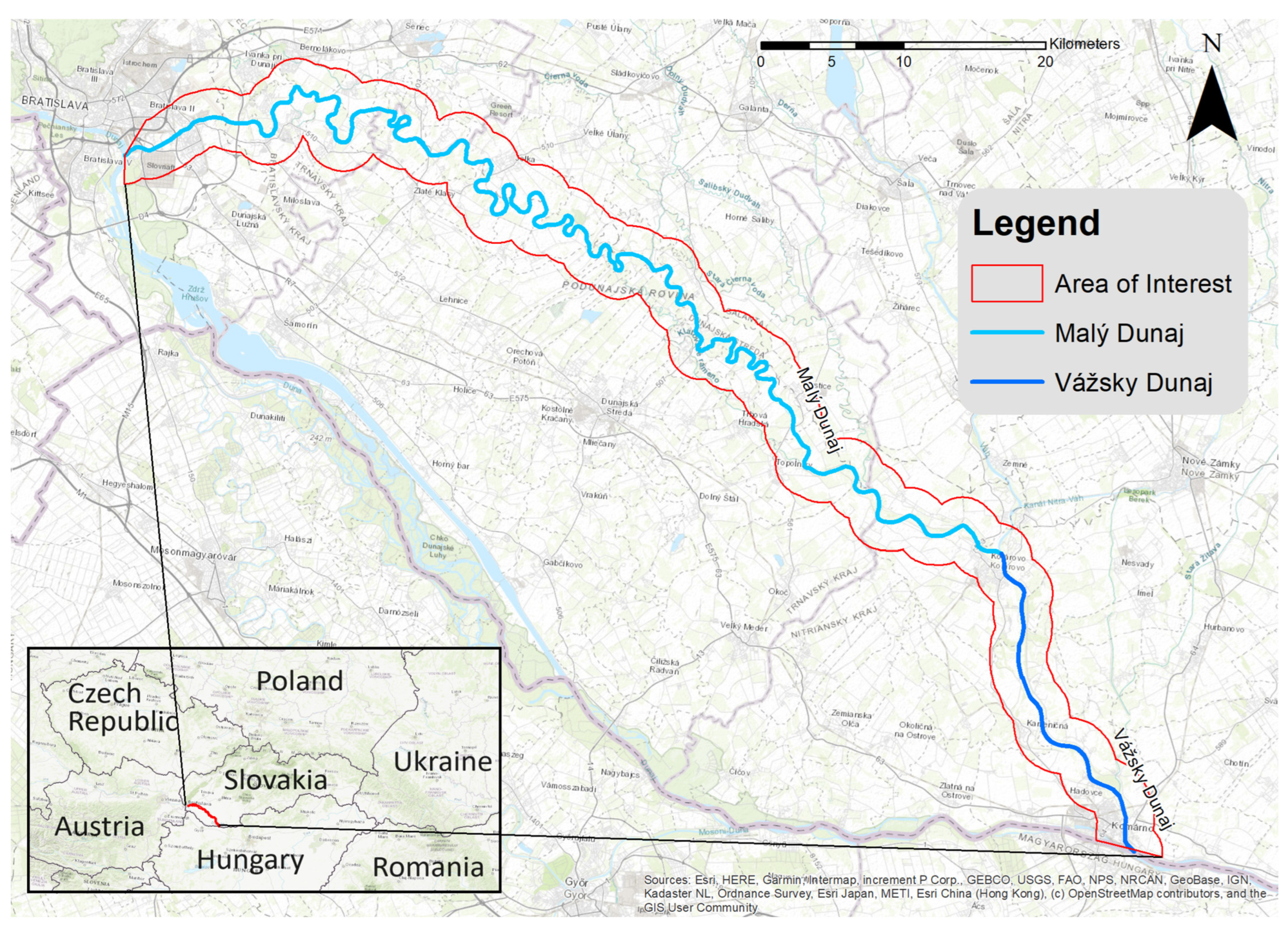

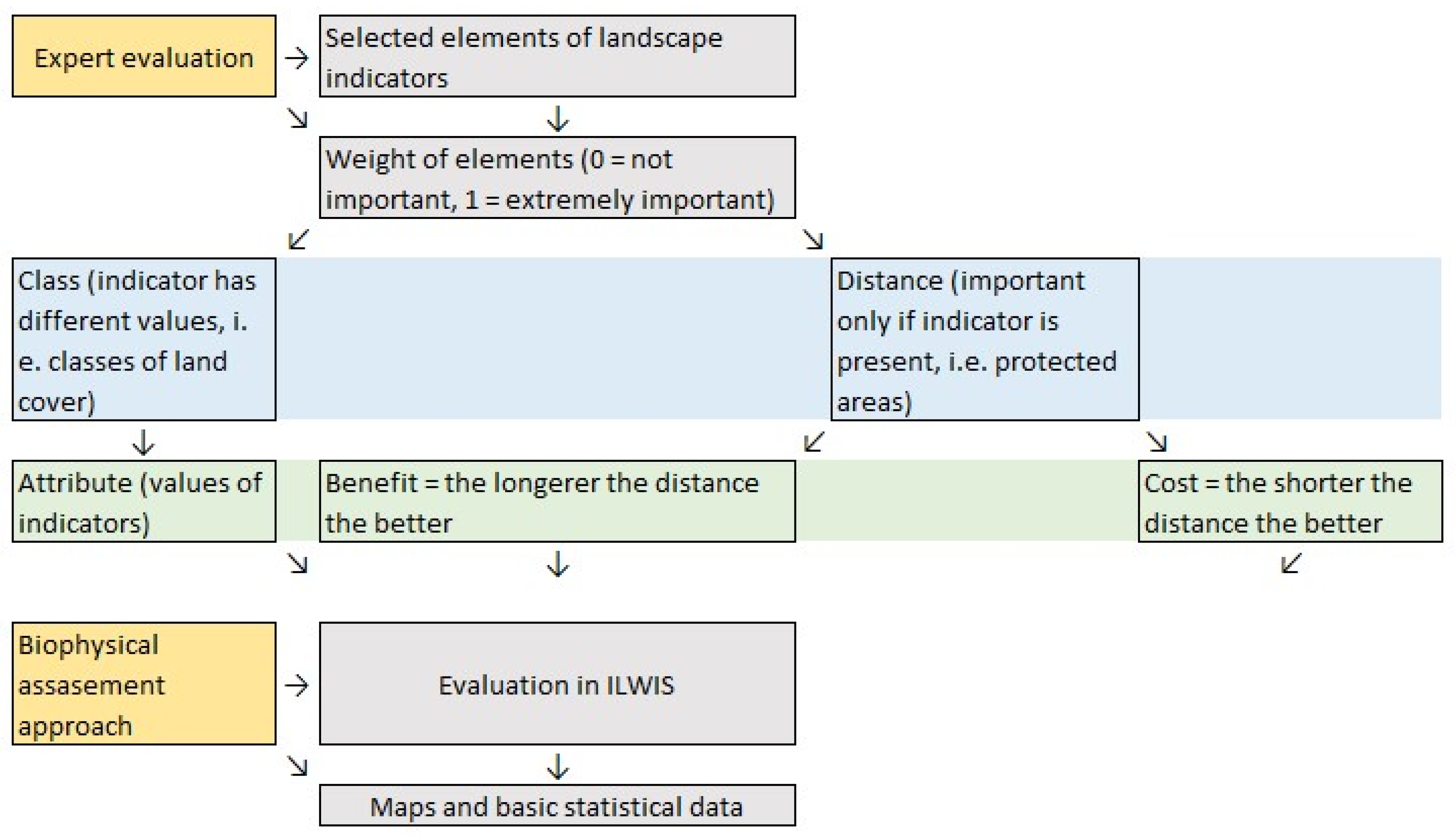
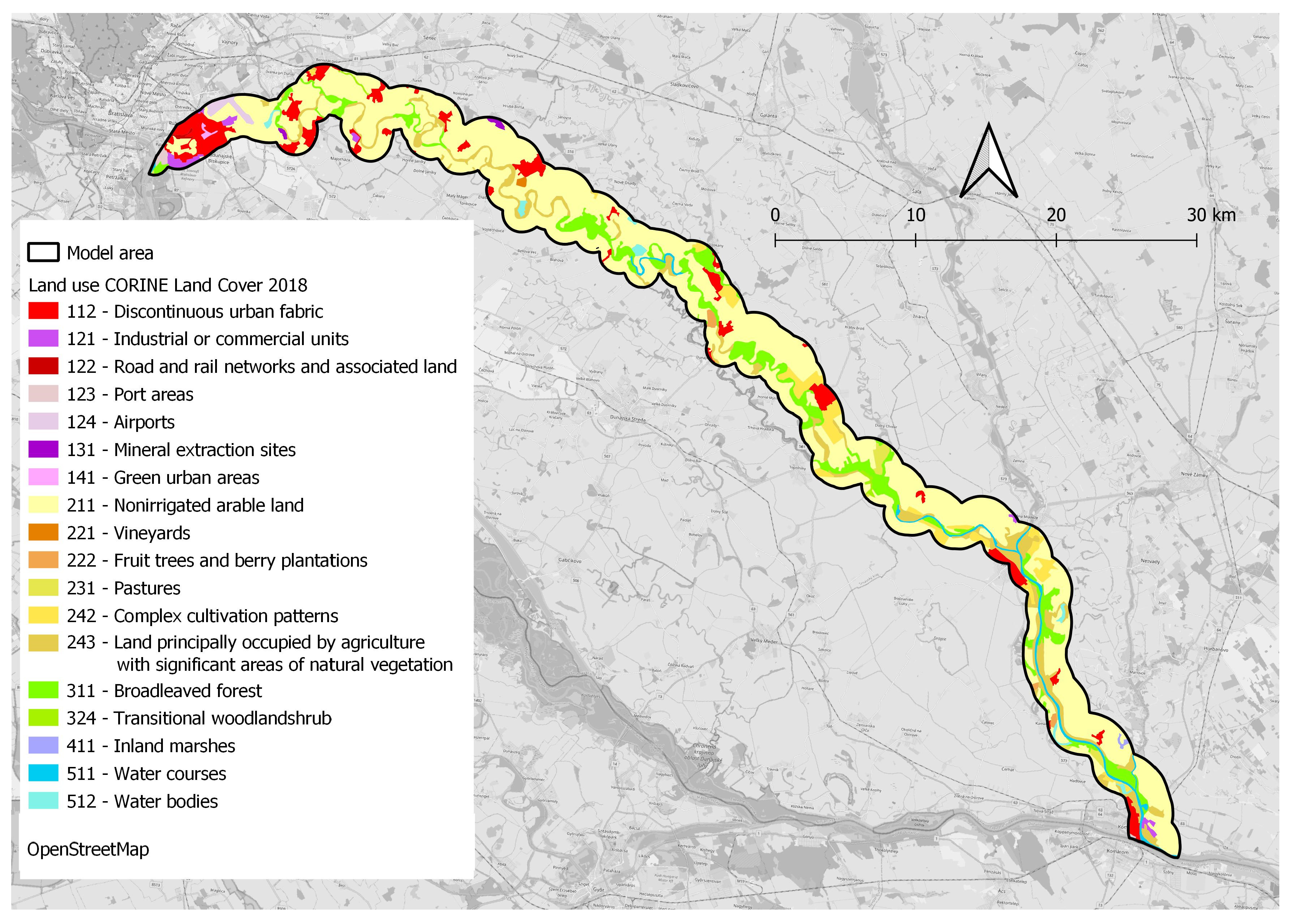
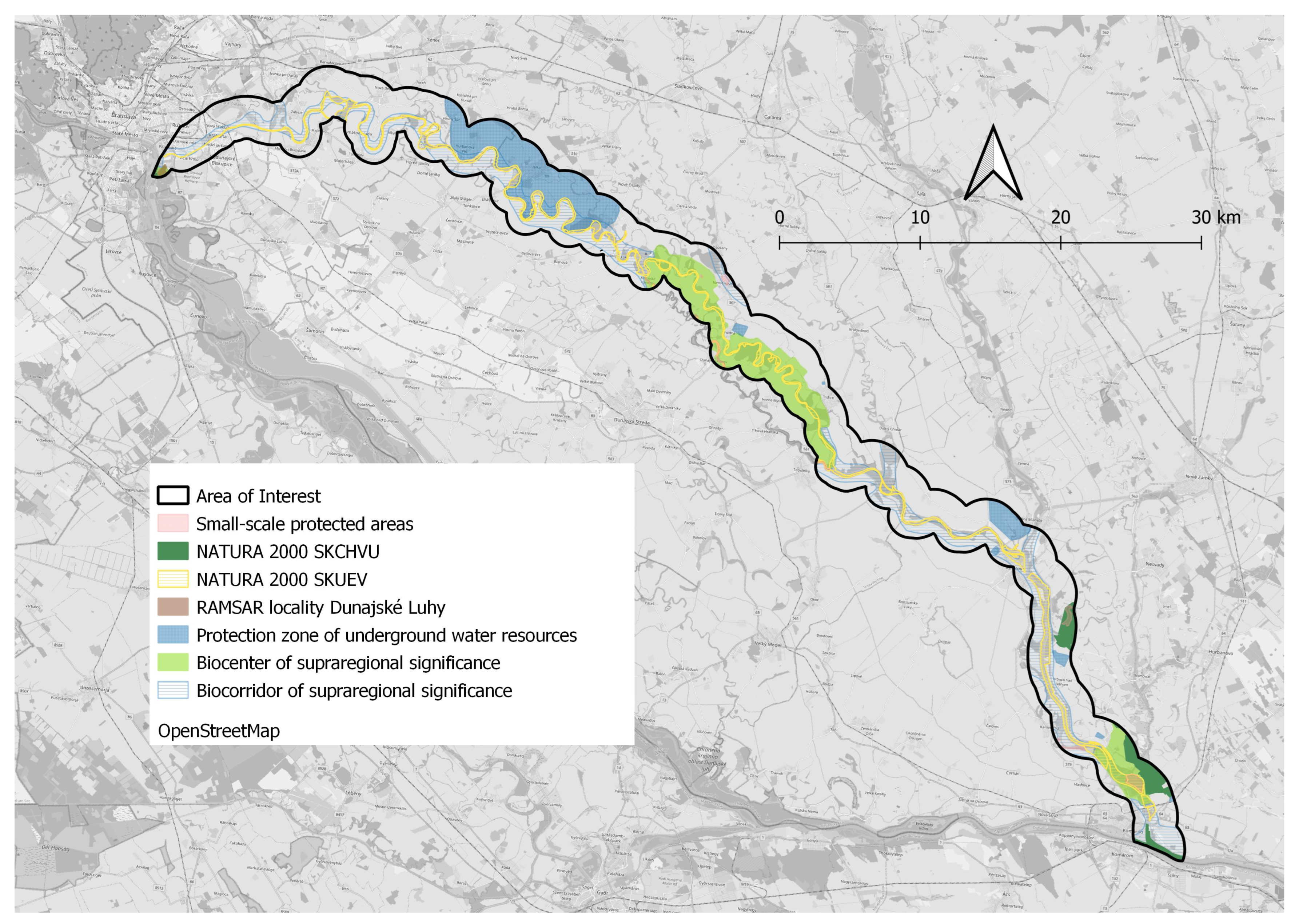
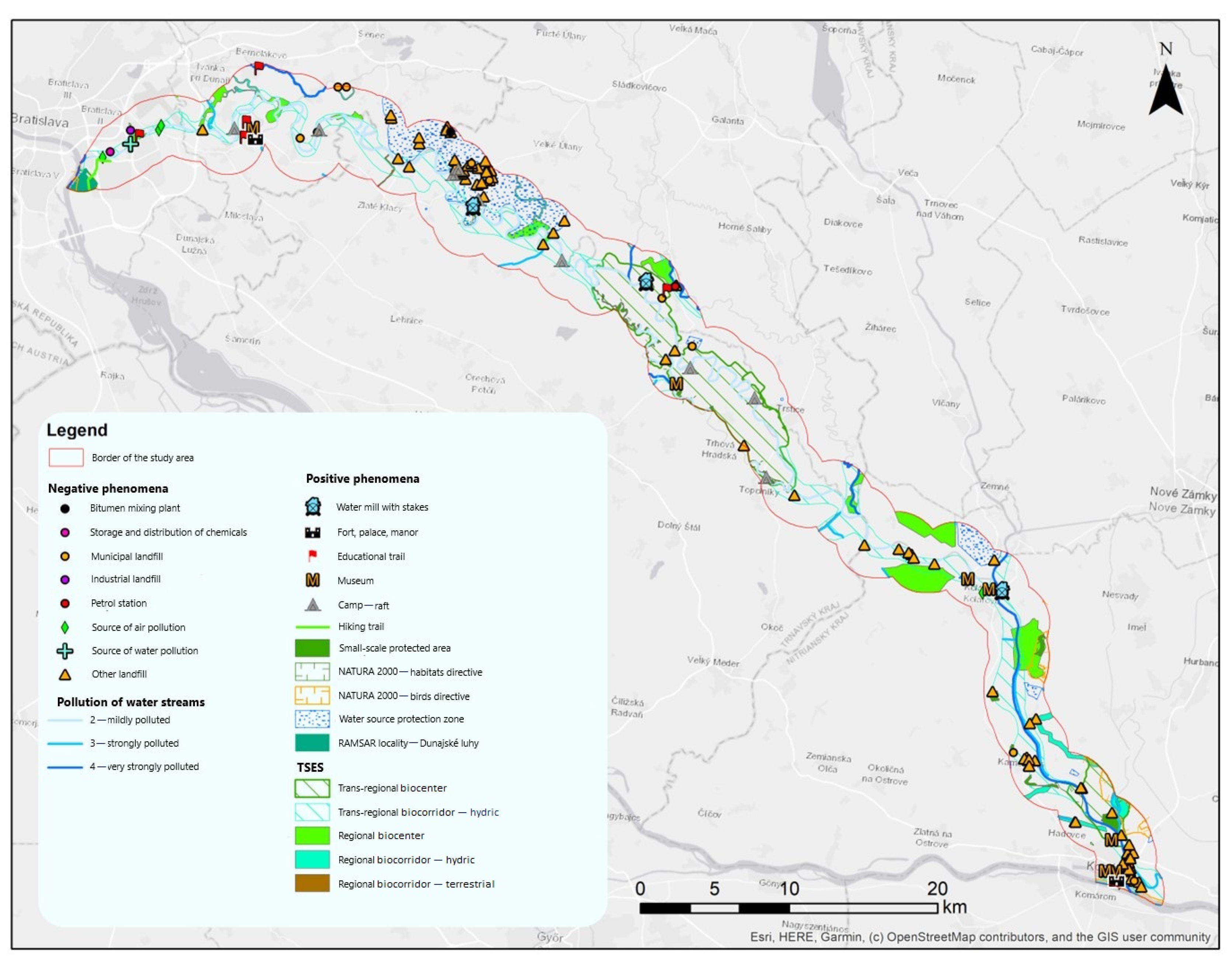
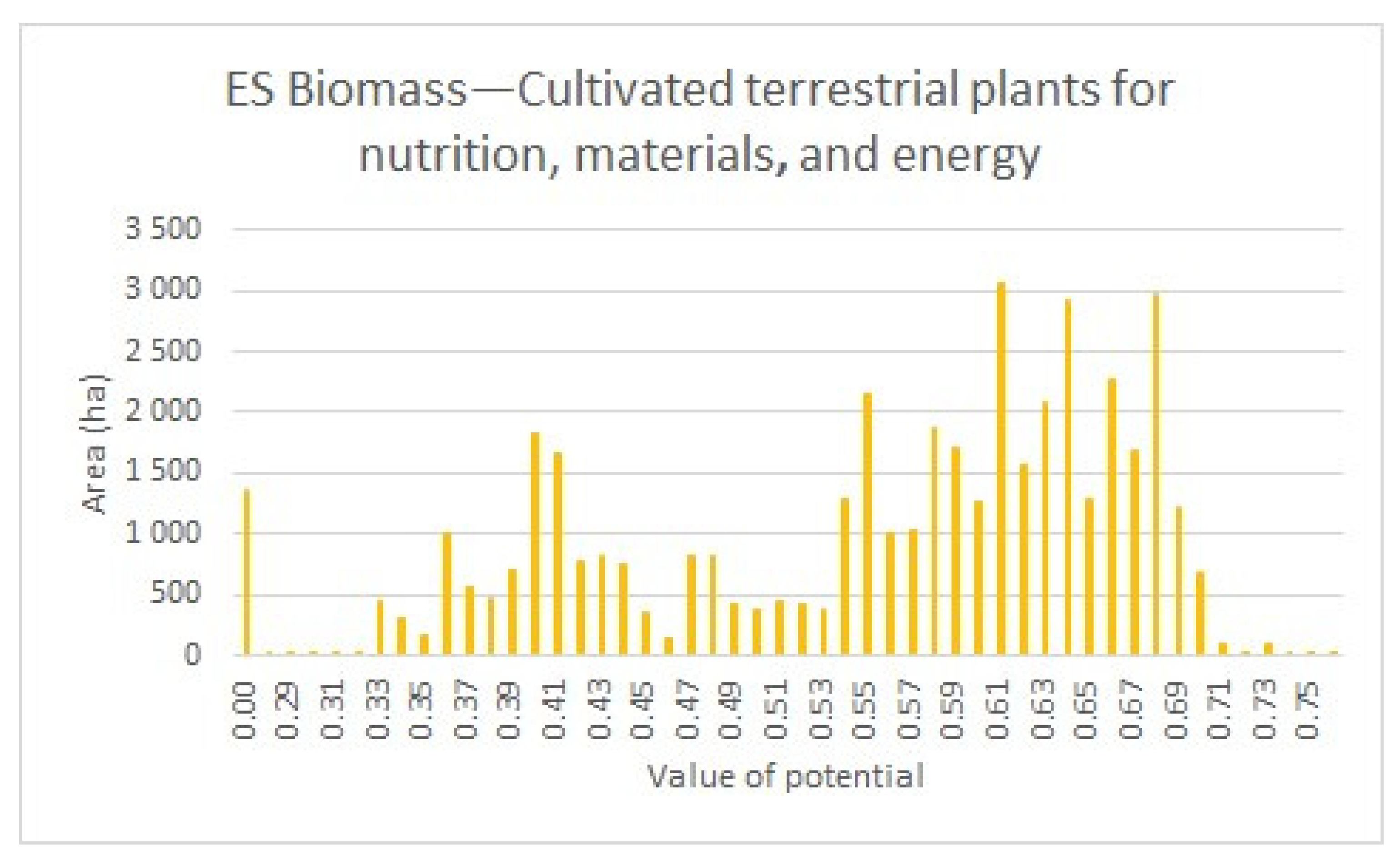
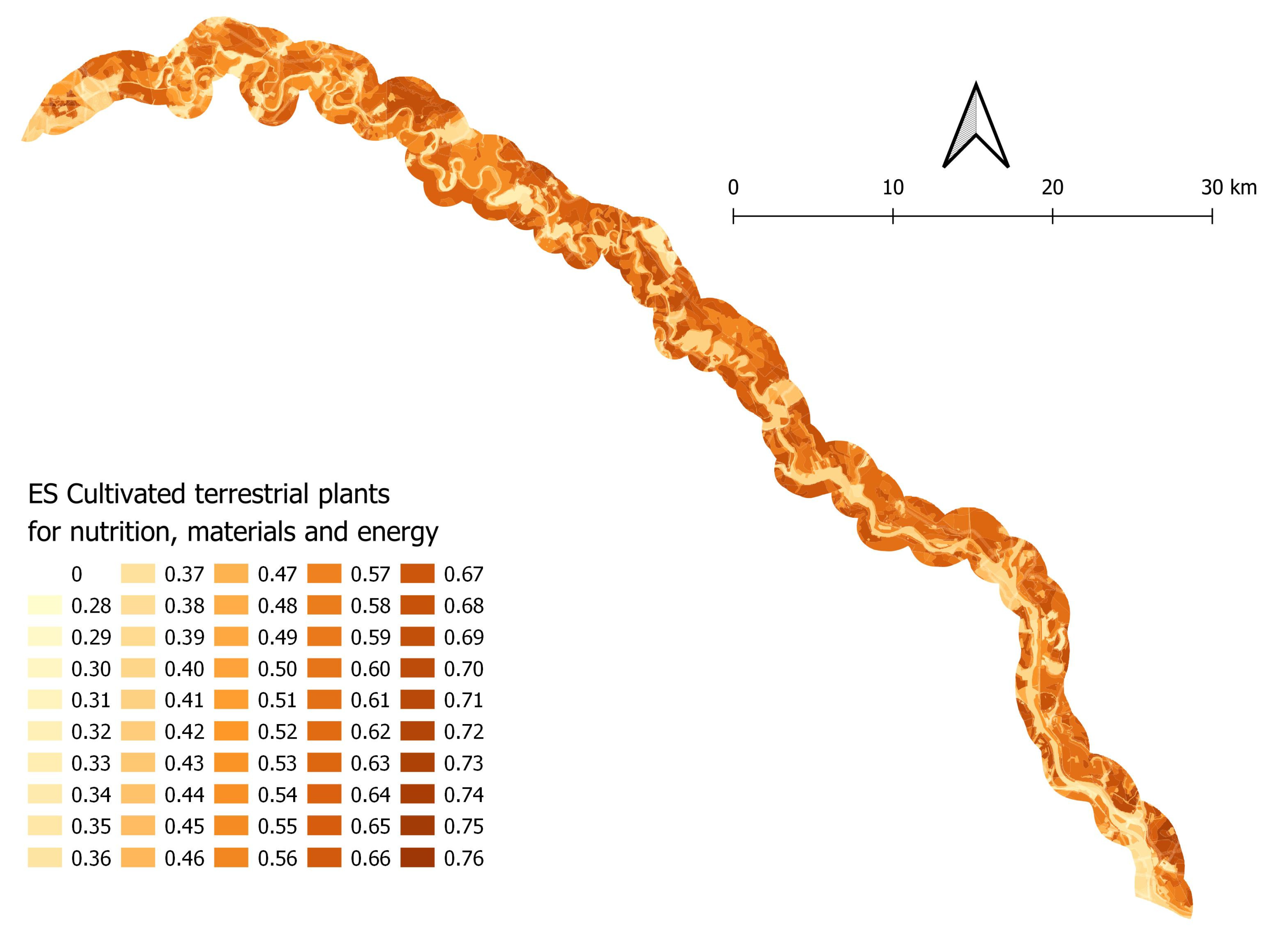
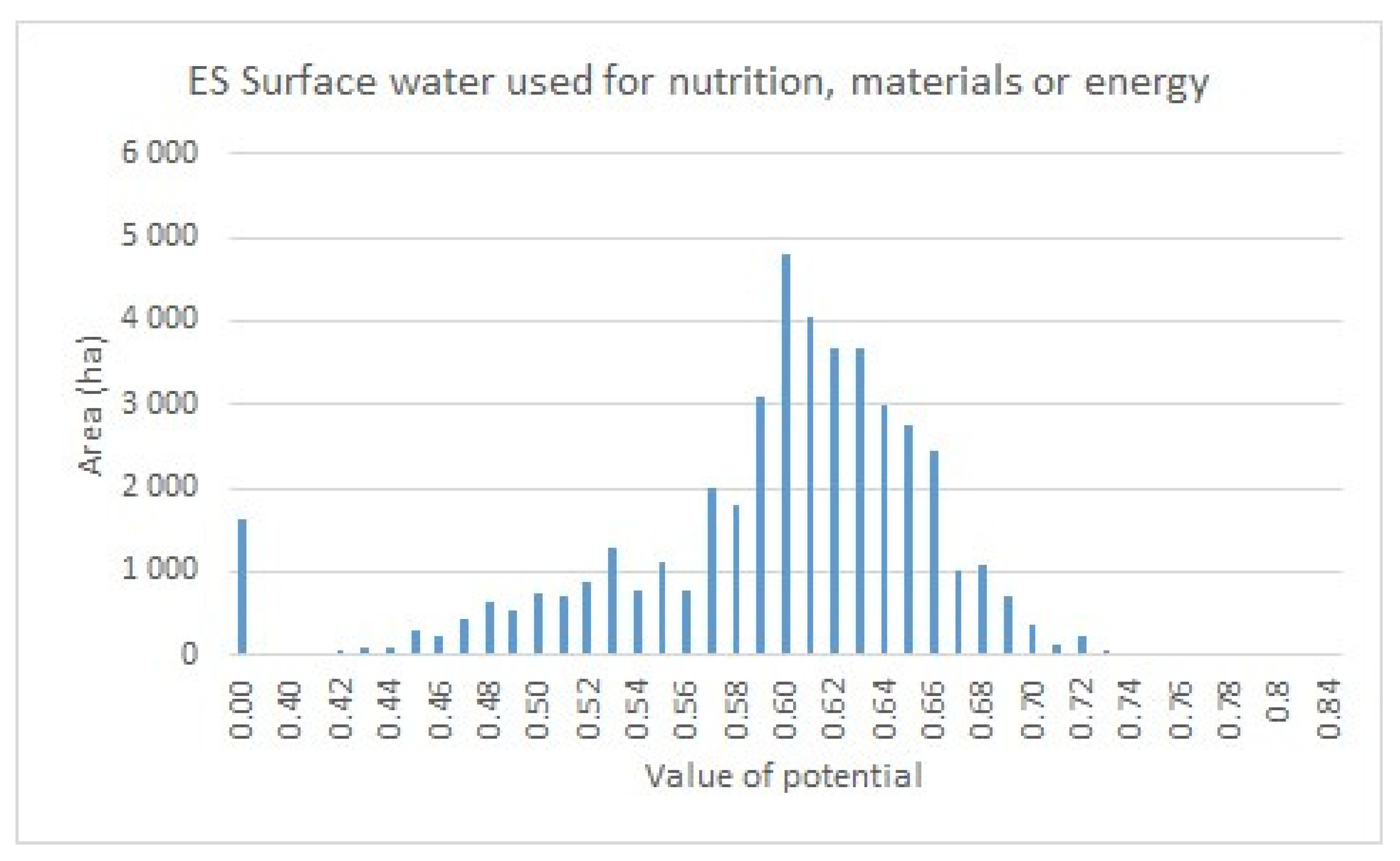
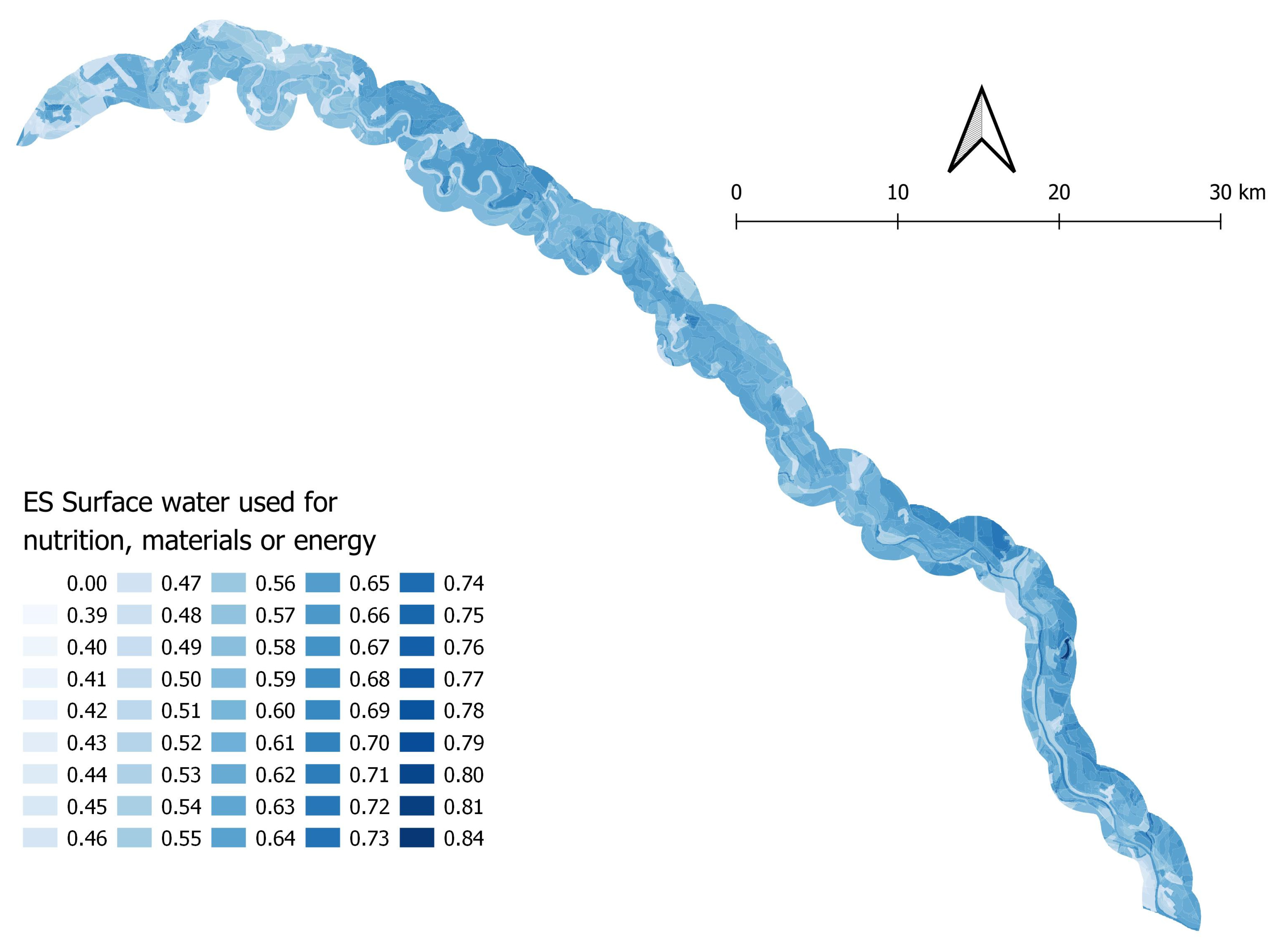

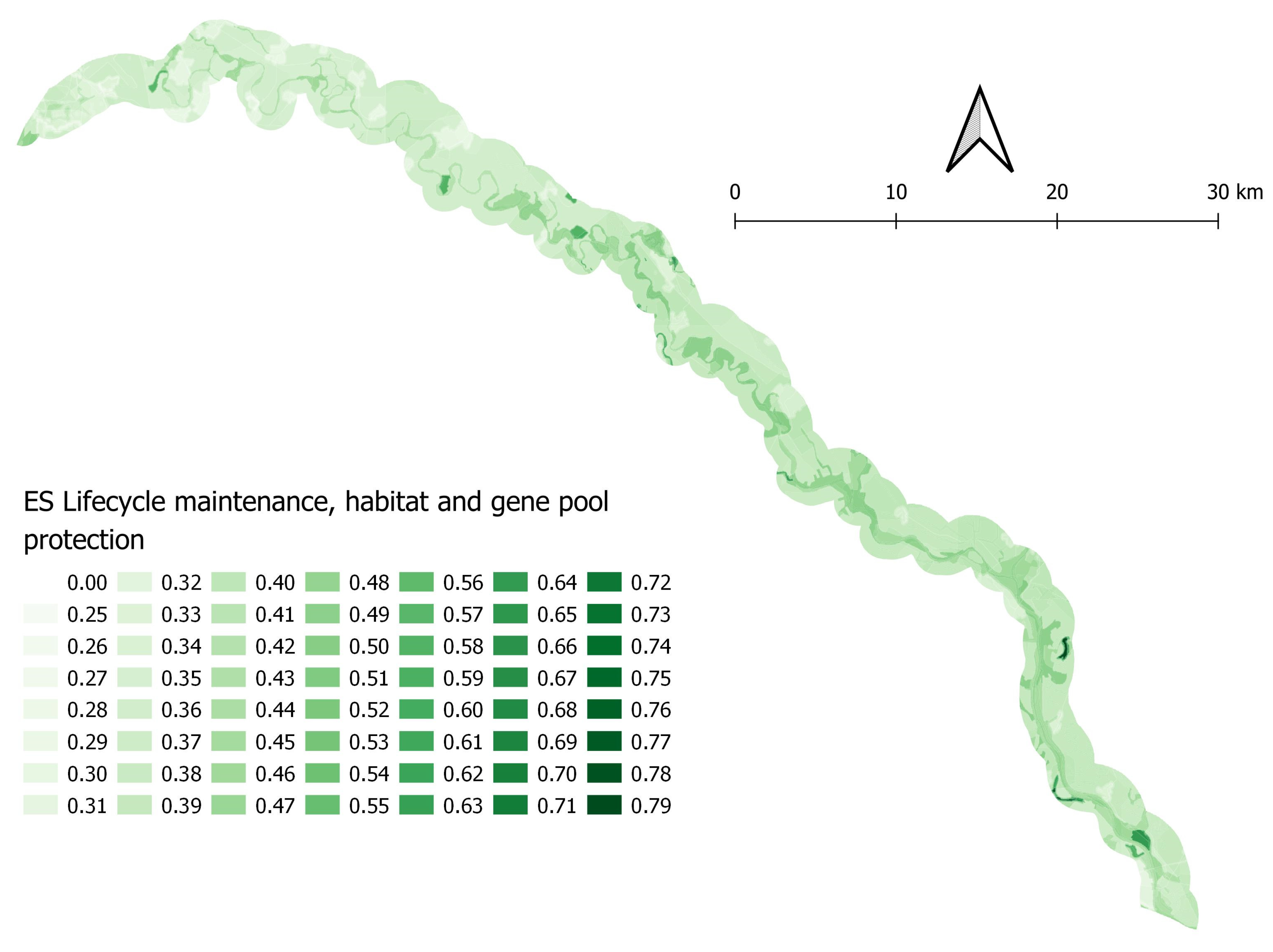
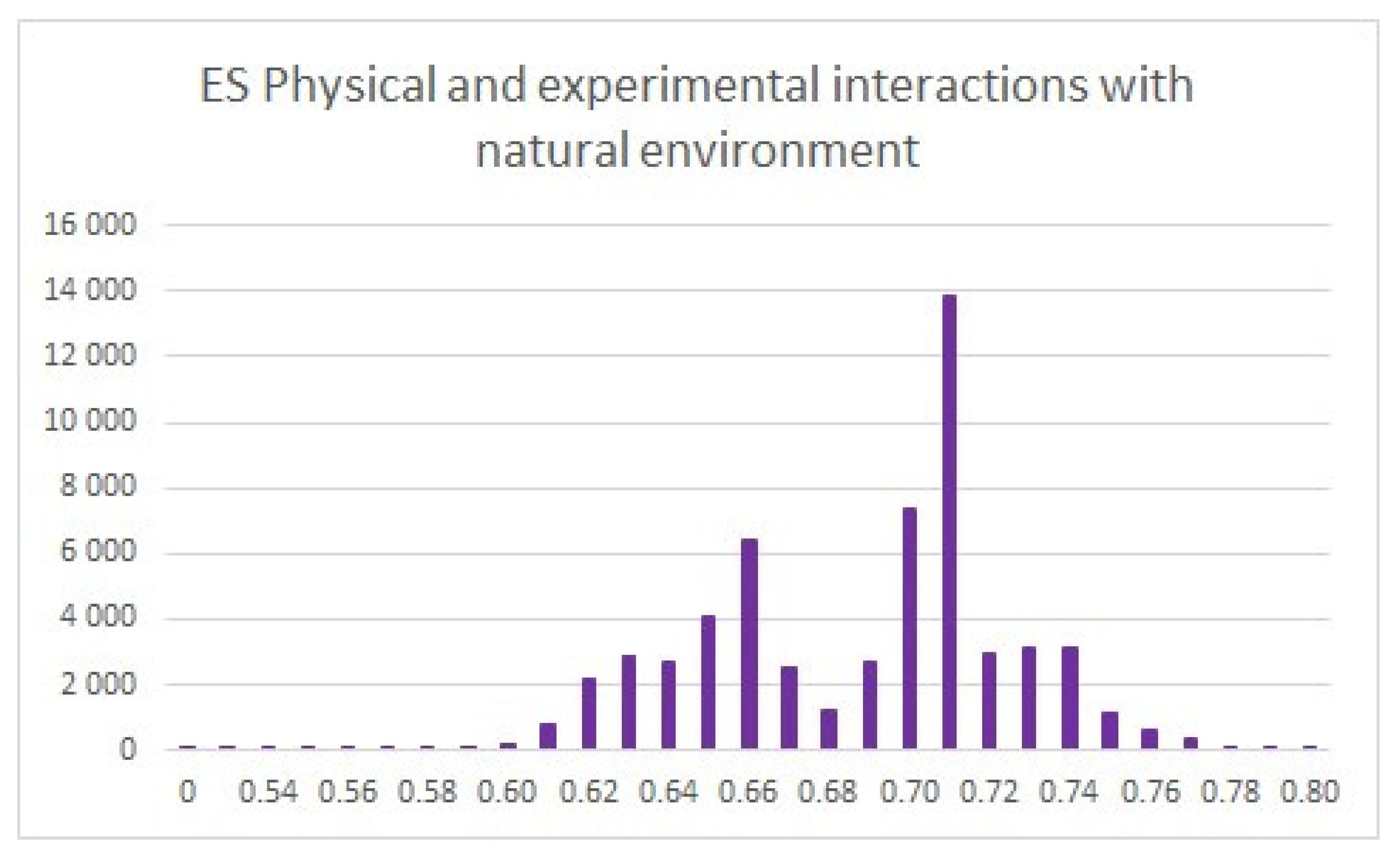

| Landscape Indicators | Elements of Landscape Indicators | Provisioning (Biotic) ESs | Provisioning (Abiotic) ESs | Regulation and Maintenance ESs | Cultural ESs | ||||||||
|---|---|---|---|---|---|---|---|---|---|---|---|---|---|
| Biomass Provisioning—Cultivating Crops | Water for Non-Drinking Purposes | Lifecycle Maintenance, Habitat and Gene Pool Protection | Physical and Experiential Interactions with Natural Environment | ||||||||||
| Weight | Evaluated as | Consider as | Weight | Evaluated as | Consider as | Weight | Evaluated as | Consider as | Weight | Evaluated as | Consider as | ||
| Land cover | 0.5 | Class 4 | Attribute 7 | 1 | Class 4 | Attribute 7 | 1 | Class 4 | Attribute 7 | - | - | - | |
| Land use | Built-up area (urban) | 1 | Distance 5 | Benefit 8 | 0.2 | Distance 5 | Benefit 8 | 0.8 | Distance 5 | Benefit 8 | 0.2 | Distance 5 | Cost 9 |
| Built-up area (transport) | 0.2 | Distance 5 | Benefit 8 | 0.2 | Distance 5 | Benefit 8 | 0.3 | Distance 5 | Benefit 8 | 0.8 | Distance 5 | Benefit 8 | |
| Built-up area (industry) | 1 | Distance 5 | Benefit 8 | 0.7 | Distance 5 | Benefit 8 | 1 | Distance 5 | Benefit 8 | 0.2 | Distance 5 | Cost 9 | |
| Mine, dumps, and construction | - | - | - | - | - | - | - | - | - | 0.9 | Distance 5 | Benefit 8 | |
| Arable land | 0.5 | Distance 5 | Cost 9 | - | - | - | 0.4 | Distance 5 | Benefit 8 | 0.4 | Distance 5 | Cost 9 | |
| Permanent crops | 0.5 | Distance 5 | Cost 9 | 0.1 | Distance 5 | Benefit 8 | - | - | - | - | - | - | |
| Grasslands and pastures | 0.4 | Distance 5 | Cost 9 | - | - | - | - | - | - | 0.5 | Distance 5 | Cost 9 | |
| Forest | - | - | - | - | - | - | - | - | - | 0.6 | Distance 5 | Cost 9 | |
| Wetlands | - | - | - | 0.9 | Distance 5 | Cost 9 | - | - | - | 0.6 | Distance 5 | Cost 9 | |
| Water bodies and streams | - | - | - | 1 | Distance 5 | Cost 9 | 0.8 | Distance 5 | Cost 9 | 0.7 | Distance 5 | Cost 9 | |
| Morphology | 1 | Class 4 | Attribute 7 | - | - | - | 0.4 | Class 4 | Attribute 7 | - | - | - | |
| Soil quality | 1 | Class 4 | Attribute 7 | 1 | Class 4 | Attribute 7 | - | - | - | - | - | - | |
| Water quality | 0.5 | Value 6 | Cost 9 | - | - | - | - | - | - | - | - | - | |
| Naturalness of habitat | - | - | - | - | - | - | 1 | Class 4 | Benefit 8 | - | - | - | |
| Tourist attractions | - | - | - | - | - | - | - | - | - | 0.7 | Distance 5 | Cost 9 | |
| Pressures | Accelerated runoff/flood risk | 0.2 | Value 6 | Benefit 8 | 0.2 | Value 6 | Benefit 8 | 0.2 | Value 6 | Benefit 8 | - | - | - |
| Air, water, and soil pollution, sources of pollution | 0.2 | Distance 5 | Benefit 8 | 0.9 | Value 6 | Benefit 8 | 0.5 | Value 6 | Benefit 8 | 0.9 | Distance 5 | Benefit 8 | |
| Legislated protection of nature | MCHÚ and VCHÚ 1 | 0.5 | Distance 5 | Benefit 8 | 0.8 | Distance 5 | Cost 9 | 1 | Distance 5 | Cost 9 | 0.7 | Distance 5 | Cost 9 |
| ÚSES 2 | 0.5 | Distance 5 | Benefit 8 | 0.8 | Distance 5 | Cost 9 | 0.5 | Distance 5 | Cost 9 | - | - | - | |
| UEV 3 | 0.5 | Distance 5 | Benefit 8 | 0.8 | Distance 5 | Cost 9 | - | - | - | - | - | - | |
| Protected water management area/water sources | - | - | - | 1 | Distance 5 | Cost 9 | - | - | - | - | - | - | |
| Land Use | Area (ha) |
|---|---|
| Arable land | 31,860.14 |
| Broad-leaved forest | 4576.11 |
| Urban fabric | 3067.15 |
| Meadows and pastures | 2896.10 |
| Water bodies | 1549.60 |
| Permanent crops | 1195.31 |
| Industrial, commercial, and transport units | 1184.56 |
| Unknown forests | 848.07 |
| Inland wetlands | 162.25 |
| Artificial, nonagricultural vegetated areas | 114.97 |
| Sparsely vegetated areas | 75.25 |
| Coniferous forest | 47.58 |
| Mixed forest | 33.82 |
| Mine, dump, and construction sites | 6.45 |
| Other forests | 1.09 |
| Total | 47,618.43 |
| Ecosystem Service | Min. | Max. | Mean |
|---|---|---|---|
| Biomass provisioning—cultivating crops | 0.25 | 0.76 | 0.51 |
| Water for non-drinking purposes | 0.39 | 0.84 | 0.60 |
| Lifecycle maintenance, habitat, and gene pool protection | 0.51 | 0.80 | 0.70 |
| Physical and experiential interactions with the natural environment | 0.24 | 0.79 | 0.52 |
Disclaimer/Publisher’s Note: The statements, opinions and data contained in all publications are solely those of the individual author(s) and contributor(s) and not of MDPI and/or the editor(s). MDPI and/or the editor(s) disclaim responsibility for any injury to people or property resulting from any ideas, methods, instructions or products referred to in the content. |
© 2023 by the authors. Licensee MDPI, Basel, Switzerland. This article is an open access article distributed under the terms and conditions of the Creative Commons Attribution (CC BY) license (https://creativecommons.org/licenses/by/4.0/).
Share and Cite
Miklósová, V.; Kozelová, I. Conflicts of the Land Use and Ecosystem Services in the Riverine Landscape of the Little Danube. Water 2023, 15, 4221. https://doi.org/10.3390/w15244221
Miklósová V, Kozelová I. Conflicts of the Land Use and Ecosystem Services in the Riverine Landscape of the Little Danube. Water. 2023; 15(24):4221. https://doi.org/10.3390/w15244221
Chicago/Turabian StyleMiklósová, Viktória, and Ivana Kozelová. 2023. "Conflicts of the Land Use and Ecosystem Services in the Riverine Landscape of the Little Danube" Water 15, no. 24: 4221. https://doi.org/10.3390/w15244221





